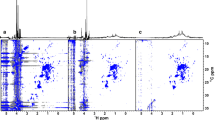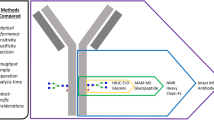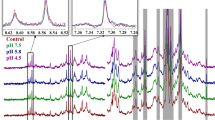Abstract
Monoclonal antibodies (mAbs) compounded into the hospital pharmacy are widely used nowadays. Their fast identification after compounding and just before administration to the patient is of paramount importance for quality control at the hospital. This remains challenging due to the high similarity of the structure between mAbs. Analysis of the ultraviolet spectral data of four monoclonal antibodies (cetuximab, rituximab, bevacizumab, and trastuzumab) using unsupervised principal component analysis led us to focus exclusively on the second-derivative spectra. Partial least squares-discriminant analysis (PLS-DA) applied to these data allowed us to build models for predicting which monoclonal antibody was present in a given infusion bag. The calibration of the models was obtained from a k-fold validation. A prediction set from another batch was used to demonstrate the ability of the models to predict well. PLS-DA models performed on the spectra of the region of aromatic amino acid residues presented high ability to predict mAb identity. The region corresponding to the tyrosine residue reached the highest score of good classification with 89 %. To improve the score, standard normal variate (SNV) preprocessing was applied to the spectral data. The quality of the optimized PLS-DA models was enhanced and the region from the tyrosine/tryptophan residues allowed us excellent classification (100 %) of the four mAbs according to the matrix of confusion. The sensitivity and specificity performance parameters assessed this excellent classification. The usefulness of the combination of UV second-derivative spectroscopy to multivariate analysis with SNV preprocessing demonstrated the unambiguous identification of commercially available monoclonal antibodies.

PLS-DA models on the spectra of the region of aromatic amino acid residues allows mAb identification with high prediction





Similar content being viewed by others

References
Breedveld F. Therapeutic monoclonal antibodies. Lancet. 2000;355:735–40.
Reichert JM, Rosensweig CJ, Faden LB, Dewitz MC. Monoclonal antibody successes in the clinic. Nat Biotechnol. 2005;23:1073–8.
Reichert JM. Antibodies to watch in 2013: mid-year update. mAbs. 2013;5:513–7.
Kirkwood JM, Butterfield LH, Tarhini AA, Zarour H, Kalinski P, Ferrone S. Immunotherapy of cancer in 2012. CA Cancer J Clin. 2012;62:309–35.
Beck A, Wagner-Rousset E, Ayoub D, Van Dorsselaer A, Sanglier-Cianférani S. Characterization of therapeutic antibodies and related products. Anal Chem. 2013;85:715–36.
Filpula D. Antibody engineering and modification technologies. Biomol Eng. 2007;24:201–15.
Demarest SJ, Glaser SM. Antibody therapeutics, antibody engineering, and the merits of protein stability. Curr Opin Drug Discovery Dev. 2008;11:675–87.
Ruuls SR, van Bueren JJ L, van de Winkel JGJ, Parren PWHI. Novel human antibody therapeutics: the age of the Umabs. Biotechnol J. 2008;3:1157–71.
Magdelaine-Beuzelin C, Kaas Q, Wehbi V, Ohresser M, Jefferis R, Lefranc M-P, et al. Structure–function relationships of the variable domains of monoclonal antibodies approved for cancer treatment. Crit Rev Oncol Hematol. 2007;64:210–25.
Kwong Glover ZW, Gennaro L, Yadav S, Demeule B, Wong PY, Sreedhara A. Compatibility and stability of pertuzumab and trastuzumab admixtures in i.v. infusion bags for coadministration. J Pharm Sci. 2012;102:794–812.
Jaccoulet E, Smadja C, Prognon P, Taverna M. Capillary electrophoresis for rapid identification of monoclonal antibodies for routine application in hospital. Electrophoresis. 2015;36:2050–6.
Poppe L, Jordan JB, Lawson K, Jerums M, Apostol I, Schnier PD. Profiling formulated monoclonal antibodies by 1H NMR spectroscopy. Anal Chem. 2013;85:9623–9.
Mahler H, Muller R, Frieb W, Delille A, Matheus S. Induction and analysis of aggregates in a liquid IgG1-antibody formulation. Eur J Pharm Biopharm. 2005;59:407–17.
Mach H, Middaugh CR. Ultraviolet spectroscopy as a tool in therapeutic protein development. J Pharm Sci. 2011;100:1214–27.
Bazin C, Vieillard V, Astier A, Paul M. Reliable real-time analytical control of monoclonal antibodies chemotherapies preparations on Multispec automaton. Ann Pharm Fr. 2010;68:163–77.
Garidel P, Hoffmann C, Blume A. A thermodynamic analysis of the binding interaction between polysorbate 20 and 80 with human serum albumins and immunoglobulins: a contribution to understand colloidal protein stabilisation. Biophys Chem. 2009;143:70–8.
Lee HJ, McAuley A, Schilke KF, McGuire J. Molecular origins of surfactant-mediated stabilization of protein drugs. Adv Drug Deliv Rev. 2011;63:1160–71.
Balestrieri C, Colonna G, Giovane A, Irace G, Servillo L. Second-derivative spectroscopy of proteins. Eur J Biochem. 1978;90:433–40.
Merrick MF, Pardue HL. Evaluation of absorption and first- and second-derivative spectra for simultaneous quantification of bilirubin and hemoglobin. Clin Chem. 1986;32:598–602.
Rojas FS, Ojeda CB, Pavon JM. Derivative ultraviolet–visible region absorption spectrophotometry and its analytical applications. Talanta. 1988;35:753–61.
Kueltzo LA, Ersoy B, Ralston JP, Middaugh CR. Derivative absorbance spectroscopy and protein phase diagrams as tools for comprehensive protein characterization: a bGCSF case study. J Pharm Sci. 2003;92:1805–20.
Lucas LH, Ersoy BA, Kueltzo LA, Joshi SB, Brandau DT, Thyagarajapuram N, et al. Probing protein structure and dynamics by second-derivative ultraviolet absorption analysis of cation–π interactions. Protein Sci Publ Protein Soc. 2006;15:2228–43.
Mach H, Arvinte T. Addressing new analytical challenges in protein formulation development. Eur J Pharm Biopharm. 2011;78:196–207.
Paul M, Vieillard V, Jaccoulet E, Astier A. Long-term stability of diluted solutions of the monoclonal antibody rituximab. Int J Pharm. 2012;436:282–90.
Wold S, Sjöström M, Eriksson L. PLS-regression: a basic tool of chemometrics. Chemom Intell Lab Syst. 2001;58:109–30.
Xie L, Ying Y, Ying T, Yu H, Fu X. Discrimination of transgenic tomatoes based on visible/near-infrared spectra. Anal Chim Acta. 2007;584:379–84.
Pieters S, Vander Heyden Y, Roger J-M, D’Hondt M, Hansen L, Palagos B, et al. Raman spectroscopy and multivariate analysis for the rapid discrimination between native-like and non-native states in freeze-dried protein formulations. Eur J Pharm Biopharm. 2013;85:263–71.
Boggia R, Casolino MC, Hysenaj V, Oliveri P, Zunin P. A screening method based on UV–Visible spectroscopy and multivariate analysis to assess addition of filler juices and water to pomegranate juices. Food Chem. 2013;140:735–41.
Barbosa-García O, Ramos-Ortíz G, Maldonado JL, Pichardo-Molina JL, Meneses-Nava MA, Landgrave JEA, et al. UV–vis absorption spectroscopy and multivariate analysis as a method to discriminate tequila. Spectrochim Acta A Mol Biomol Spectrosc. 2007;66:129–34.
Ma JC, Dougherty DA. The cation–π interaction. Chem Rev. 1997;97:1303–24.
Wang W, Singh S, Zeng DL, King K, Nema S. Antibody structure, instability, and formulation. J Pharm Sci. 2007;96:1–26.
Peter Wuelfing W, Kosuda K, Templeton AC, Harman A, Mowery MD, Reed RA. Polysorbate 80 UV/vis spectral and chromatographic characteristics—defining boundary conditions for use of the surfactant in dissolution analysis. J Pharm Biomed Anal. 2006;41:774–82.
Maity H, Wei A, Chen E, Haidar JN, Srivastava A, Goldstein J. Comparison of predicted extinction coefficients of monoclonal antibodies with experimental values as measured by the Edelhoch method. Int J Biol Macromol. 2015;77:260–5.
Wang X, Singh SK, Kumar S. Potential aggregation-prone regions in complementarity-determining regions of antibodies and their contribution towards antigen recognition: a computational analysis. Pharm Res. 2010;27:1512–29.
Acknowledgments
The authors wish to thank Pr. Patrice Prognon for helpful discussion and the European Hospital Georges Pompidou for kindly providing the therapeutic mAbs.
Author information
Authors and Affiliations
Corresponding author
Ethics declarations
Conflict of interest
The authors declare no conflict of interest.
Rights and permissions
About this article
Cite this article
Jaccoulet, E., Boccard, J., Taverna, M. et al. High-throughput identification of monoclonal antibodies after compounding by UV spectroscopy coupled to chemometrics analysis. Anal Bioanal Chem 408, 5915–5924 (2016). https://doi.org/10.1007/s00216-016-9708-4
Received:
Revised:
Accepted:
Published:
Issue Date:
DOI: https://doi.org/10.1007/s00216-016-9708-4



